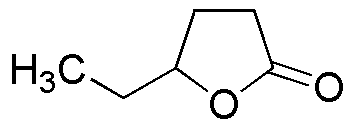|
g-Hexalactone is widely utilized in research focused on:
- Flavor and Fragrance Industry: This compound is commonly used as a flavoring agent in food products and beverages, providing a creamy, coconut-like aroma that enhances sensory experiences.
- Cosmetics and Personal Care: Its pleasant scent makes it a popular choice in formulating perfumes and skincare products, where it contributes to the overall fragrance profile and consumer appeal.
- Pharmaceuticals: g-Hexalactone serves as a building block in the synthesis of various pharmaceutical compounds, aiding in the development of new medications with improved efficacy.
- Research Applications: In academic and industrial research, it is used as a model compound to study reaction mechanisms and the behavior of lactones, providing insights into organic synthesis.
- Polymer Chemistry: This compound can be utilized in the production of biodegradable polymers, contributing to sustainable materials that meet environmental standards.
General Information
Properties
Safety and Regulations
Applications
g-Hexalactone is widely utilized in research focused on:
- Flavor and Fragrance Industry: This compound is commonly used as a flavoring agent in food products and beverages, providing a creamy, coconut-like aroma that enhances sensory experiences.
- Cosmetics and Personal Care: Its pleasant scent makes it a popular choice in formulating perfumes and skincare products, where it contributes to the overall fragrance profile and consumer appeal.
- Pharmaceuticals: g-Hexalactone serves as a building block in the synthesis of various pharmaceutical compounds, aiding in the development of new medications with improved efficacy.
- Research Applications: In academic and industrial research, it is used as a model compound to study reaction mechanisms and the behavior of lactones, providing insights into organic synthesis.
- Polymer Chemistry: This compound can be utilized in the production of biodegradable polymers, contributing to sustainable materials that meet environmental standards.
Documents
Safety Data Sheets (SDS)
The SDS provides comprehensive safety information on handling, storage, and disposal of the product.
Product Specification (PS)
The PS provides a comprehensive breakdown of the product’s properties, including chemical composition, physical state, purity, and storage requirements. It also details acceptable quality ranges and the product's intended applications.
Certificates of Analysis (COA)
Search for Certificates of Analysis (COA) by entering the products Lot Number. Lot and Batch Numbers can be found on a product’s label following the words ‘Lot’ or ‘Batch’.
*Catalog Number
*Lot Number
Certificates Of Origin (COO)
This COO confirms the country where the product was manufactured, and also details the materials and components used in it and whether it is derived from natural, synthetic, or other specific sources. This certificate may be required for customs, trade, and regulatory compliance.
*Catalog Number
*Lot Number
Safety Data Sheets (SDS)
The SDS provides comprehensive safety information on handling, storage, and disposal of the product.
DownloadProduct Specification (PS)
The PS provides a comprehensive breakdown of the product’s properties, including chemical composition, physical state, purity, and storage requirements. It also details acceptable quality ranges and the product's intended applications.
DownloadCertificates of Analysis (COA)
Search for Certificates of Analysis (COA) by entering the products Lot Number. Lot and Batch Numbers can be found on a product’s label following the words ‘Lot’ or ‘Batch’.
*Catalog Number
*Lot Number
Certificates Of Origin (COO)
This COO confirms the country where the product was manufactured, and also details the materials and components used in it and whether it is derived from natural, synthetic, or other specific sources. This certificate may be required for customs, trade, and regulatory compliance.

